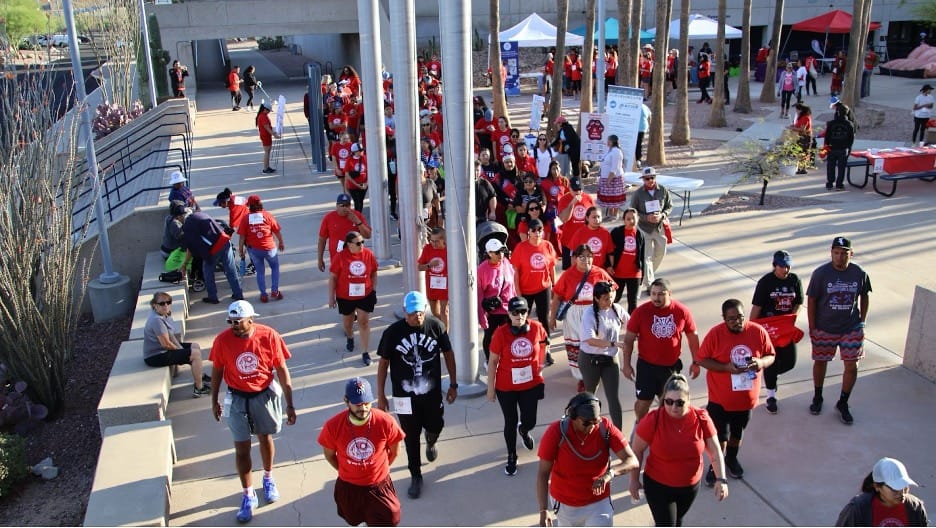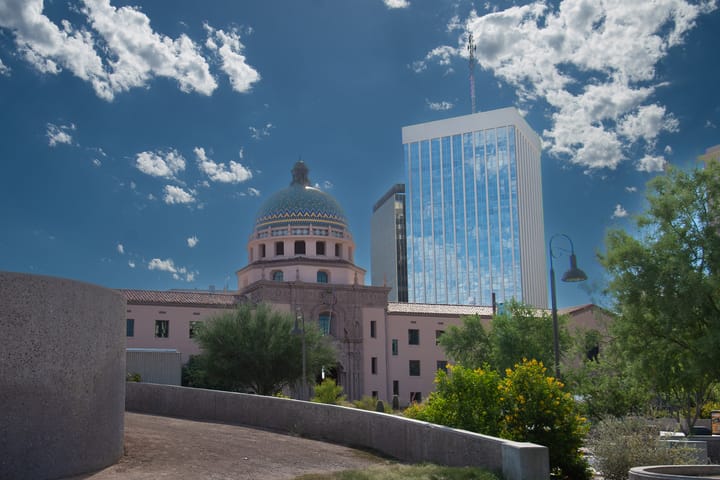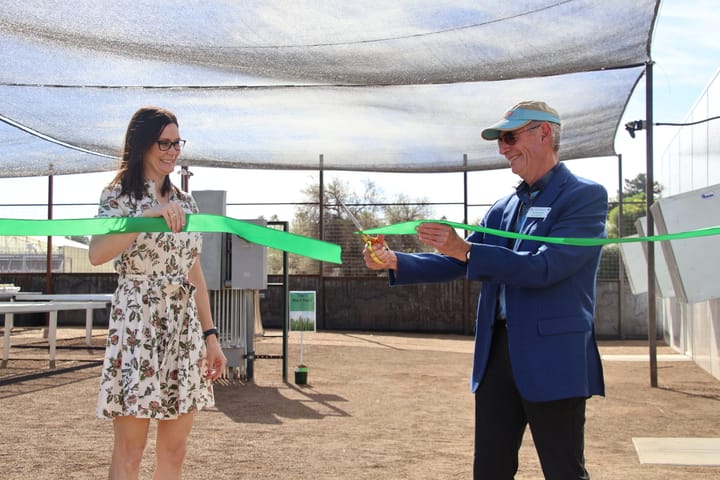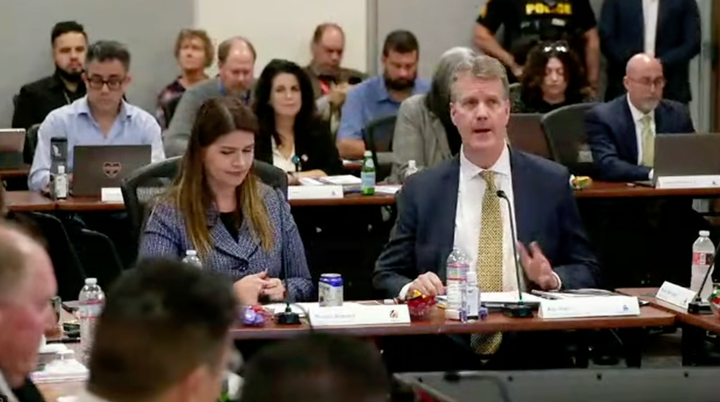Events spotlight local efforts in Missing and Murdered Indigenous People crisis
Through walks, a symposium and community gatherings, Tucson advocates are building support networks and demanding justice for missing and murdered Indigenous people.

As the crisis of missing and murdered Indigenous people gains national attention, local efforts in Tucson are building community, raising awareness and demanding change.
The IndigiWellbeing Program under the University of Arizona’s Zuckerman College of Public Health hosted a walk and symposium earlier this month, kicking off May’s Missing and Murdered Indigenous Peoples Awareness Month.
The program was founded in response to the mental health needs of Native students, staff, faculty and community members during the pandemic.
From book signings and exercise classes to powwows, the program offers events and opportunities for knowledge sharing that are culturally grounded in Native and Indigenous perspectives, fostering a sense of connection as a path to health and wellness.
“We started this to raise awareness for missing, murdered indigenous people, and it evolved into being not just a run, but a healing event as well,” said founder Felina Cordova-Marks, an assistant professor in the Department of Health Promotion Sciences.
The Missing and Murdered Indigenous Peoples Movement began in Canada in 2015, where grassroots efforts such as organizing marches, building databases of those missing, and holding local community, city council and tribal meetings pressured the Canadian government to launch a commission to investigate the cases in 2017. The government declared the situation a national crisis.
According to a study by the Urban Indian Health Institute, Arizona ranks third in the nation for the number of cases involving murdered and missing Indigenous women and girls, with Tucson tied for third among U.S. cities with the most cases.
Arizona currently has 95 open cases of missing Indigenous people.
On Saturday, May 3, community members arrived early for the 5th Annual Southern Arizona Missing and Murdered Indigenous Peoples Day of Awareness Walk. They were given runners’ bibs with space to write the name of or a message about someone they were running for that day.

One participant, who asked to remain anonymous, had the words “For Barbara” written across her bib, honoring her high school friend from the Saint Regis Mohawk Tribe in the northern region of New York.
Barbara was a victim of domestic violence and was ultimately killed by her partner.
The woman said high-profile cases, like Gabby Petito’s, highlight disparities in media coverage and public perception of missing persons. While young white women often receive significant media attention, missing people of color do not receive the same focus, the participant said.
We need “more attention given to not only natives, but other minorities,” she said. Barbara’s death “was 40 years ago. It was a rez case. Nobody cared.”
The walk included blessings, music and dances, and a resource fair with representatives from several community organizations supporting Native and Indigenous individuals.
“It was important to us to raise awareness and give people a space to heal and come together in community (so that) those that have been personally affected can get support services they need, and for other people to be aware of the situation,” Cordova-Marks said.
First Women Gather Around the Fire is an Indigenous women-led organization that meets the first Monday of every month at St. Andrew’s Episcopal Church for a fire circle.

Founding member Denise Miller said the events aim to empower Native women by “living fully as we were created: physically, mentally, emotionally and spiritually.”
“We're here to offer support and for our missing and murdered loved ones, to pray for them, to come together in the intention, when we (gather) around the fire, we remember our sisters,” Miller said. “We're really dedicated to supporting women in coming together in a sisterhood for healing, for connection (and) support.”
Natividad Cano, a licensed independent substance abuse counselor with the Haven’s Native Ways Program, spoke about the importance of uplifting Native and Indigenous practices.
The Haven is a nonprofit addiction rehabilitation provider for mothers in recovery. Its Native Ways Program supports Native and Indigenous women by incorporating culture, traditions and spiritual practices into recovery services.
“Culture heals,” Cano said. “We have to help each other in community. There's a lot of wisdom in the culture. (The program) teaches ways of healing, ceremonies, drumming, storytelling and talking (circles). We return to those traditions from time immemorial to the present.”
On Monday, May 5, IndigiWellbeing hosted its 4th Annual National Missing and Murdered Indigenous Peoples Day of Awareness Symposium, bringing together experts and community members from Southern Arizona and beyond.
The event began with a panel of Miss Native American UA ambassadors. First Attendant Masie Ortega told attendees how Toka, a traditional O’odham game played by women, became a symbol of community strength and awakening.

She said that a collective voice, knowledge and traditions can inspire community advocacy.
“We as indigenous people are overlooked so often that we need to understand that nobody is going to fight for us but us, because we are the only ones that understand our pain. We need to understand that we all have knowledge of our own,” Ortega said. “We all have people that have gone missing, and it is only our voice that can be used to fight for our rights. We are all warriors, because as people we have lost, as a people we have mourned, and as a people, we will heal.”
Daelyn Nez, the UA’s 2025–2026 Miss Native American ambassador, said storytelling can be a tool for healing and advocacy, sharing her own experience with domestic violence.
“I tell my story, not just because it matters, but because it's my truth,” Nez said. “I tell my story for those who are afraid to speak, for the families who are still searching and impacted by this crisis, and for the ones who didn't survive and for the ones who still can. There's a true power in storytelling.”
Pima County Attorney Laura Conover spoke about the county’s efforts to improve access to justice for Indigenous communities through its Missing and Murdered Indigenous Women and Girls Task Force.
“We need to be honest about how very serious the problem is and how little attention is being paid, at least off the tribe and off the reservation,” Conover said. “It’s far past time that we should have been using those agreements to talk about the absolutely unacceptable epidemic of missing and murdered Indigenous women and children and people.”
Arizona Luminaria Diné journalist Chelsea Curtis created and maintains a database of missing and murdered Indigenous people in Arizona, while also uplifting the stories of those directly impacted by disappearances.
Curtis said that empathetic storytelling and sensitivity in handling information have helped build trust with communities that have historically been disregarded by the media.
“The goal was to not only have statistics, but to humanize those statistics by writing compelling and in-depth stories about some of your families at the heart of this issue,” Curtis said. “We wanted to ensure stories are being told empathetically and accurately and with the sensitivity they deserve.”
Topacio “Topaz” Servellon is a freelance journalist out of Tucson. Contact them at topacioserve@gmail.com.
Tucson Spotlight is a community-based newsroom that provides paid opportunities for students and rising journalists in Southern Arizona. Please support our work with a paid subscription.



